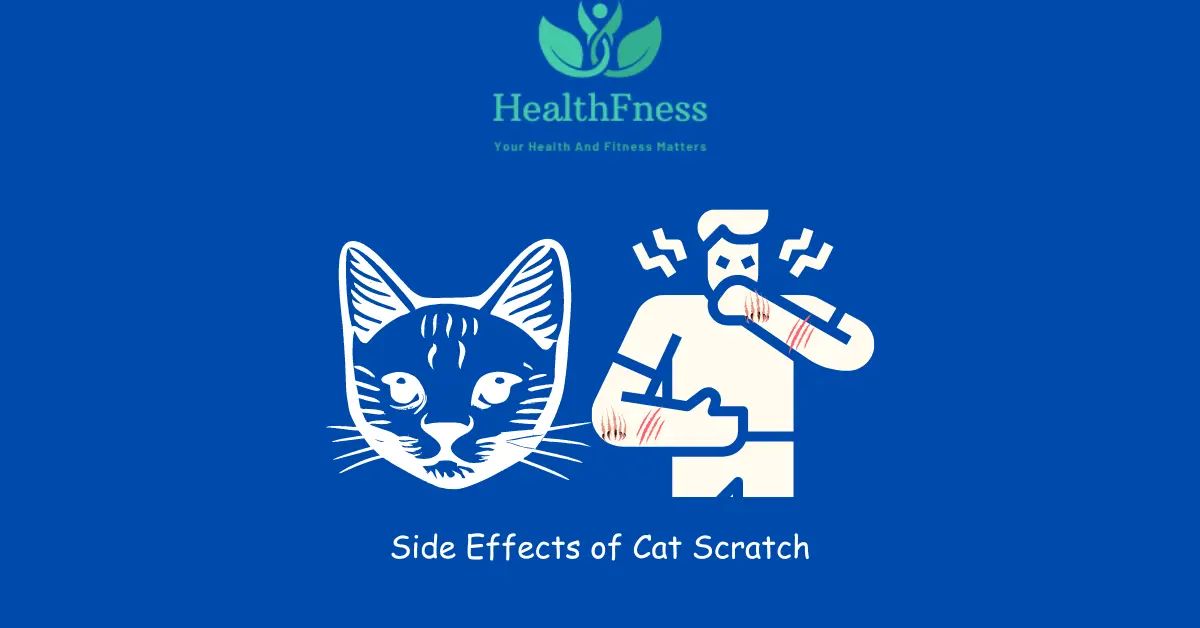So the majority of the people would like to have a pet to entertain with and bring pleasure to their lives and cats are one of the choices indeed. Cats are naturally quite friendly animals that normally do not bite or cause much harm to humans but even then the friendliest cats sometimes bite their owners or people. As mentioned above, cat scratches are often harmless but it is imperative to know if any complications may arise from the scratches. This post is going to cover the side effects of cat scratches in an effort to ensure that readers are aware of the potential dangers involved. So let’s get started!
What Is Cat Scratch?
Cat claws are so sharp that whenever they touch skin; cat scratches are formed. Cats scratch for several reasons, including play or instinctual foraging associated with hunting practices or establishing their space. While most scratches happen accidentally most of the times, it is also possible for them to be purposeful mostly when cat feels threatened or too scared.
You May Also Like To Read: Cat Scratch Disease ↗
Bacteria That Causes Cat Scratch Fever
Bartonella henselae is the main culprit behind cat scratch disease (CSD), also referred to as cat scratch fever. This bacterium is often present in the saliva of sick cats, especially young kittens, and it is spread to people through a cat’s scratch or bite. Bartonella henselae transmission between cats can also occur via fleas.
- The bacterium can enter a person’s skin and cause an infection if a cat having Bartonella henselae scratches or bites them.
- When the germs spread to the next lymph nodes they reproduce and cause immune rections. Thus, it results in an immunological reaction that leads to the pain and lymph node swelling associated with cat scratch fever.
- Bartonella henselae is the primary antibody-associated bacterium related to cat scratch fever; however, other microorganisms in the genus Bartonella are implicated as causes of other diseases that are similar. These include, among others, Bartonella clarridgeiae and Bartonella koehlerae.
You May Also Like To Read: Cat Scratch Fever ↗
Side Effects of Cat Scratch
Skin Irritation and Inflammation
Skin discomfort and inflammation are two of the most typical aftereffects of cat scratching. Vertebrate cat can cause pain, swelling and redness due to the small scratch or abrasion on the skin due to a cat’s sharp claw. To prevent getting infected it is paramount to clean the area that was damaged very properly.
Infection
Kittens can scratch and leave irritations that may lead to infections. Cat claws have sharp points that might injure and expose the animal’s skin and thus provide an entry point for pathogens. Inflammation, heat, pain, redness or redness, purulent discharge and painful lymph nodes indicates that a tooth is infected. If there are symptoms of infection it is recommended that the food is tested or advice from the doctor is sought.
Allergic Reactions
It is the nature of cats to have sharp claws that may lead to allergic reactions in some people. If the skin is in contact with the substance long enough, the frequency of exposure can trigger an allergic reaction and the symptoms may vary from itching and hives to anaphylactic shock. If I have known sensitivities or have such responses, I will talk with the healthcare provider.
Tetanus
The bacteria Clostridium tetani would release toxins that cause tetanus in the body body after entering through a wound. Even while cat scratches may not directly cause tetanus, it is nevertheless crucial to check your tetanus vaccination status, particularly if the scratch is deep or unclean.
Cat Scratch Disease Long Term Effects
Some potential long-term consequences of cat scratch disease include the following:
Lymph Node Enlargement
The most frequent long-term impact of CSD is the swelling of lymph nodes close to the area where the cat bit or scratched. The technical term for this type of swelling is lymphadenopathy and may even last for a couple of weeks or months before subsiding. There are few cases in which lymph nodes are left and cause a lot of pain and in that case surgical removal of lymph nodes may be resorted to.
Chronic Fatigue
Though CSD symptoms usually resolve in 7-10 days, individuals with this disease may still feel tired or fatigued. This is referred to as Post-infectious fatigue syndrome where the syndrome can last for several months. This symptom can be prevented by resting, elimination of unhealthy food and reintroduction of the daily mundane activities.
Neurological Consequences
Although this is very rare, CSD can lead to neurologic complications, which may include encephalitis (inflammation of the brain), seizures, or other abnormalities in the central nervous system. People with weakened immune systems or underlying medical disorders are more prone to have these consequences. If any neurological symptoms appear, it is critical to seek immediate medical assistance.
Eye Infections
Rarely, CSD can result in ocular problems including conjunctivitis (pink eye) or uveitis (inflammation of the uvea, the central layer of the eye), which are infections of the eyes. If these diseases become chronic, they may require management by an ophthalmologist for damage to the eye or to prevent long-term visual impairment.
You May Also Like To Read: How to Keep Your Eyes Healthy ↗
Systemic Infections
Even though such infections are extremely rare, the disseminated infections of the bacteria in the entire body may occur with individuals whose immune systems are compromised. We are talking about serious complications that may require lengthy medical treatment and involve a lot of internal organs.
You May Also Like To Read: The Clinical Profile of Cat-Scratch Disease’s Neuro-Ophthalmological Effects ↗
What Is Bacterial Infection From Cat Scratch?
The infection or bacterial infection from cat scratch is the term used to describe an infection that develops when bacteria make their way into the body via cuts that a cat’s claws have made. Some cats may be infected but show no symptoms; the unseen bacteria on their claws can potentially enter the skin through scratching. The most common etiologic agent associated with cat bites is B henselae.
- Blood loss can occur in the skin upon being scratched by a cat and this causes an opening through which bacteria can enter into the body causing an illness.
- Pus may form around the injured region and there may be redness, swelling, warmth, pain, and other signs of a bacterial infection caused by a cat scratch.
- Sometimes, the lymph nodes close by can also swell and hurt.
How Do I Know If A Cat Scratch Is Infected?
For prompt intervention and appropriate treatment, it is crucial to know if a cat scratch is infected or not. The following symptoms could point to an infected cat scratch:
Increased Redness: While some redness is normal after a fresh scratch if the area around the wound develops more redness over time or becomes more acute over time, it may be infected.
Swelling: If the swelling surrounding the scratched area persists, gets worse, or doesn’t go away after a few days, it might be an infection.
Pain or Tenderness: A scratch that gets worse, is tender to the touch, or throbs could be an infection.
Heat: If an infection is present, the affected area may feel warmer to the touch than the nearby skin.
Pus or Discharge: Any discharge from the wound, including pus, a yellowish or greenish fluid, or any other discharge, points to an infection. Pus is a sign of the immune system’s reaction to bacterial invasion.
Fever: If you get one along with the cat scratch, it may indicate that the illness has moved beyond the small area where it first appeared.
Swollen Lymph Nodes: Infected cat scratches can result in swelling, tenderness, or pain of adjacent lymph nodes.
FAQs
Can all cat scratches cause infections?
Even though the majority of cat scratches do not result in infections, it is crucial to clean and take care of them correctly to reduce the risk.
Are there any long-term consequences of cat scratches?
Cat scratches typically heal completely and without any lasting effects. However, if problems develop, get medical help.
Can I get tetanus from a cat scratch?
Although cat scratches may not directly cause tetanus, it is nevertheless crucial to make sure you are up to date on your tetanus immunisation, especially for severe or filthy wounds.
Can I develop an allergy to cats after being scratched?
Cat scratches can cause an allergic reaction, especially if you already have a history of allergies. Consult a medical expert for advice and an accurate diagnosis.
Conclusion
Despite being typically benign, cat scratches can have negative effects that need to be addressed. You can secure your safety and have a positive relationship with your feline friend by being aware of the potential adverse effects and taking the necessary precautions. Remember to treat scratches right away, get medical help if required, and take good care of your cat.
Video Credits:

Dr. Mark Jenkins, MD - General Physician (California, USA)
Dr. Mark Jenkins is a board-certified general physician based in the United States, specializing in preventive medicine, nutrition, and lifestyle health. With years of clinical experience in primary care, he is dedicated to helping patients and readers alike make informed, science-based decisions about their well-being.
As a trusted medical reviewer and contributor to Healthfness.com, Dr. Jenkins ensures that all health content meets the highest standards of accuracy, safety, and evidence-based medicine. His expertise bridges modern medical science with practical, everyday wellness strategies, making complex topics approachable for all audiences.
Outside the clinic, Dr. Jenkins is passionate about living the healthy lifestyle he teaches. He enjoys hiking with his dog, experimenting with vegetarian cooking, and exploring the latest health research. He believes that small, consistent lifestyle changes lead to lasting health improvements, and he aims to inspire readers to take proactive steps toward a healthier, happier life.
Explore more of Dr. Jenkins’ evidence-based insights at Healthfness.com



